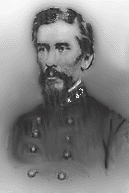
Died:Franklin, Tennessee, November 30, 1864
Confederate General
Cleburne moved to America in 1849 and practiced law in Arkansas. In 1862 he received a commission as brigadier general in the Confederate Army. One of two foreign born officers to attain the rank of major general in the Confederate armed forces, he was recognized as a skilled combat officer and distinguished himself in many battles.
At Chattanooga he repelled Sherman's attack in spite of being outnumbered 4 to 1. During the retreat from that battle he won the Battle of Ringgold Gap although Hooker had 3 men for his 1. He repeatedly faced Sherman's advancing troops during the Atlanta Campaign. After Cleburne's troops absorbed the Union assault at Pickett's Mill, he was moved to the Confederate left and was involved in the skirmishing along the Dallas line. During the Nashville Campaign he succeeded to the command of Hardee's Corps. On his way north during this campaign, Cleburne stopped at a church in Maury County Tennessee, and by local tradition was heard to comment at the cemetery of Saint John's Church that, "it is almost worth dying for to be buried in such a beautiful place." Cleburne was killed in battle a few days later at Franklin, Tennessee, on November 30, 1864 and buried here until later disinterred.
His sobriquet(nickname) was "Stonewall Jackson of the West". It would have been more accurate to call Jackson "Pat Cleburne of the East". Fighting on the western front Cleburne generally got less glory than generals in the east. Fighting under Braxton Bragg, Joseph E. Johnston, and John Bell Hood, arguably the most incapable succession of commanding officers, Cleburne repeatedly demonstrated his abilities. Fighting for the losing side he got less attention and coverage than the Union generals. But Cleburne fought for a cause(states rights), and one in which he firmly believed.
One other event affected how he was viewed during and after the war. Stationed at Tunnel Hill, Ga. after the defeat at Chattanooga, Cleburne, leading a group of commissioned officers, proposed drafting Negroes into the Confederate Army in return for their emancipation. He reasoned that in one stroke they could increase the size of the army and eliminate a reason for the Federals to fight. While it is doubtful that the resolve of President Lincoln would have been altered (he was fighting to preserve the Union, not to end slavery), the proposal caused quite a backlash in the south and possibly affected the length of the war. When Jefferson Davis decided to remove Johnston from command during the Battle of Atlanta, he selected John Bell Hood over Pat Cleburne in part because of this proposal.
Today no statue exists for this icon of the Confederacy and many of the
battlefields on which he fought are unprotected. His stand at Missionary
Ridge, the rearguard action at Ringgold Gap, bloody Pickett's Mill...